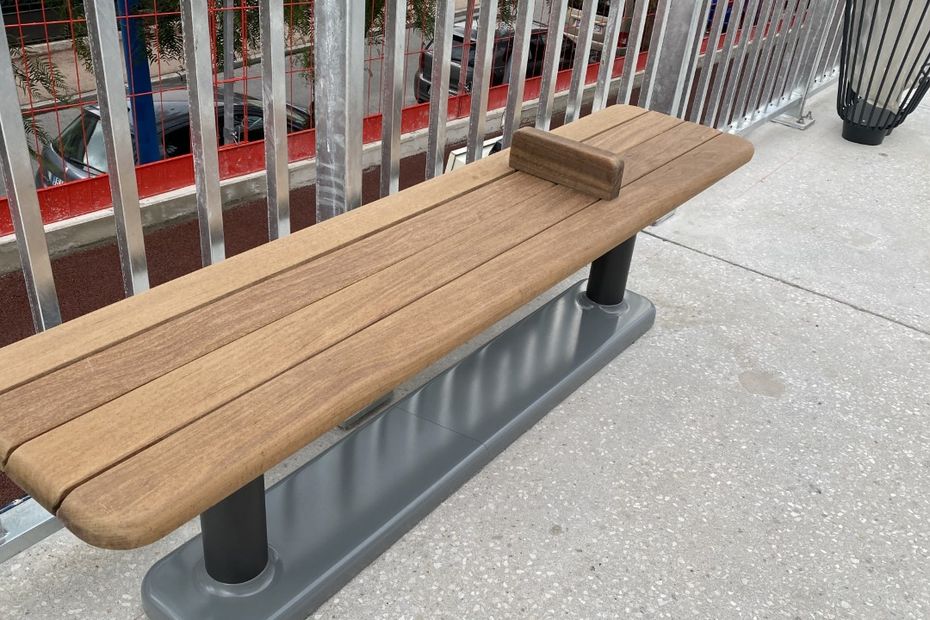Sign of the times, the most precarious, the homeless (SDF) are increasingly driven out of tourist towns, especially during the summer. Among the measures imagined by the municipalities, the street furniture supposed to prevent occupations of places. This is the submerged part of the iceberg. We investigated a real trend.
“You know the technique of the bench cut in three?” Thus Francis Vernebe destabilizes us from the start. The answer is no, because of course we never thought about it. This is one of the ways among many others to ward off undesirables, summarizes the director in the Provence Alpes – Côte d’Azur region ofEmmaus.
Because obviously we can not lie there.
When we pay a little more attention to it, we realize that the anti-SD street furnitureF is everywhere around us.
In stations, for example, new benches have appeared in recent months.
In Roquebrune-Cap-Martin in the Alpes-Maritimes, the wooden benches have a wedge.
Is it for decorative purposes or for the sake of aesthetics or to prevent anyone from lying on it ? In this story, the town hall has nothing to do with the choice of furniture because the development of the station itself is the responsibility of the SNCF.
The railway company explains thatin no way is there a desire to ban the homeless from its stations. And appeals to common sense:a bench is for sitting, not lying. On the Côte d’Azur, the stations are very busy and customers waiting for their train want to be able to rest”.
The wooden benches with wedge named armrest were designed “to allow people who have difficulty to get up more easily” they say at the Paris headquarters of the company. All stations on the Côte d’Azur will be fitted out in this way within a few years.
All this is not to the liking of associations helping the homeless. Emmaüs thus launched the hashtag #let’s be human to identify the worst street furniture even through a ceremony called les pics d’or alluding to a city in France who had put up spikes to prevent people from sitting on them.
With bitterness, Francis Vernebe makes a fairly detailed analysis of things. On the one hand, in the cities, the population which wishes not to be disturbed and on the other, everything not to go in the direction of helping part of the poorest population. “It’s a continuum of poverty, city centers don’t want to be welcoming, if you don’t consume you’re not desirable. Rather than putting in place a policy of help, it is a policy of banishment.”
Anti-homeless street furniture would therefore only be the submerged part of the iceberg. We may want to think of street furniture differently, but we would have to think about the whole population.
“The bench which is the symbol of the urban object par excellence can be pretty, artistic but it is a denial of the existence of a person who wishes to lie down on it”
Francis Vernebe specifies: “The object to which we pay little attention, because it fulfills only a minor role for us, can become a niche of security for the homeless who no longer has a home.”
The Abbé Pierre Foundation (FAP), had “distinguished” Toulon and Marseille in 2020 for their anti-homeless devices.
–
The associations we contacted explain that in large cities the phenomenon is more significant.
Paris, Marseille, Lyon but also Nice, fifth city of France.
One of these still young associations, it is only five years old and is very active on social networks. For the founder of All citizens, David Nakache, the case is heard. The worst according to him are anti-begging orders implemented by the city of Nice since 2018.
And repeated every summer. But why every summer?
“We chase the homeless from tourist areas because we must not taint the postcard explains the person concerned. We push them back into the neighborhoods”. Still, the city’s parks and gardens are closed at night.
According to the association in the so-called listed streets of Nice, the policy would be that of zero homeless. We questioned the municipality in this sense which sent us the 16 pages of the text. It is in fact begging that is prohibited in certain sectors and at certain times. There is no “risk” then of seeing a presence of the homeless, in particular Cours Saleya, Place Massena or even the Promenade des Anglais.
A municipal decree that the Human Rights League brought before the courtsx on the grounds that homeless people begging are not a nuisance to public order. The administrative court has already asked the town hall several times to review its copy in line with the LDH.
For its part, the town hall of Nice, which we contacted, reminds us that it provides the most needy with accommodation places, 80 for men and 19 for women, through several centers spread over the city.
Since July 17, the Nice CCAS opens its doors during the day, in addition to the evening, to welcome the most fragile.
–


